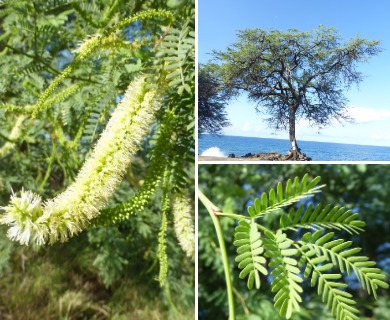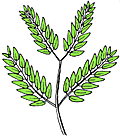Kiawe
Prosopis pallida
Pea family (Fabaceae)
Post-Cook introduction
Kiawe or algarroba, an introduced usually spiny tree, is one of the most common trees and perhaps most useful of the dry lowlands of Hawaii. Recognized by the short trunk and wide spreading thin of small twice leaves and by the beanlike narrow, slightly flattened, yellowish pods. Mimosa subfamily (Mimosoideae).

©2018 Zoya Akulova
Leaves on long twigs or short spurs, dull light green and often finely hairy, 3 inches (7.5 ) or less in length, consisting of short axis less than 1 inch (2.5 ) long and 2–3 pairs of side axes 1–1 1⁄2 inches (2.5–4 ) long, with dot between each pair. are many (8–11 pairs), stalkless, narrowly oblong, about 1⁄4 inch (6 ) long and less than 1⁄8 inch (3 ) wide, rounded at rounded and unequal-sided at base, thin.
Flower clusters (spikes) lateral, 3–4 inches (7.5–10 ) long and 5⁄8 inch (1.5 ) wide, unbranched, hanging down. Flowers very numerous, crowded, light yellow, about 1⁄4 inch (6 ) long, composed of cuplike green five- of five narrow petals, 10 threadlike and narrow with hairy curved threadlike and dot Flowering mainly in spring and summer.
(pods) few hanging from slender stalks, beanlike, yellowish, narrow and slightly flattened, 3–8 inches (7.5–20 ) long, 3⁄8 inch (1 ) wide, and 3⁄16 inch (5 ) thick, long-pointed, not splitting open, with whitish slightly sweet pulp. Seeds 10–20, each within a whitish four-angled cover, beanlike, elliptical and slightly flattened, 1⁄4 inch (6 ) long, shiny light brown.
Wood is dark reddish brown, very heavy ( gr. 0.85), extremely hard, and has low shrinkage in drying. In Hawaii, it has been made into cement floats and mallets, as well as heavy rifle stocks in match shooting. Its most common uses are charcoal, fuelwood, and fence posts. The heartwood is very resistant to decay. Though attacked by marine borers, the timber has served for piling elsewhere. The bark reportedly contains tannin and yields a brownish gum suitable for varnish, glue, and medicine.
Kiawe is one of the most useful introduced trees of Hawaii, primarily because it occupies barren lands that are otherwise unproductive. The pods serve as valuable feed for livestock in rangelands and are harvested for this purpose. It is reported that a mature tree bears up to 200 pounds (91 kg) of pods annually. The foliage is also eaten. Flowers are an important source for bees. Following the introduction of honeybees in 1857, Hawaii exported 200 tons (182 t) of kiawe honey a year. At present, most honey is produced on Niihau and Molokai.
This species has become established as the most common tree in the lowland dry zone of Hawaii from sea level to about 2000 ft (610 ) altitude. It covers an estimated 90,000 acres (36,473 ha) of barren soils throughout the islands. It grows on coastal sand, old lava flows, and clay soils with rainfall as low as 10 inches (250 ) per year. It is not salt tolerant and is defoliated by salt spray from winter storms.
Though large trees are ornamental and grow rapidly, planting near buildings is not recommended. The trees have shallow root systems and may be uprooted during storms. Also, and more importantly, the large thorns on twigs that fall from the trees make walking barefoot beneath the tree very hazardous and painful. The thorns readily penetrate soft-soled shoes.
Introduction of this species has been traced to seed from a Peruvian tree growing in the royal garden at Paris (Judd 1916). The seed was planted by Father Bachelot in 1828 in the Catholic Mission ground in Honolulu. By 1840 It was common as a shade tree throughout Honolulu, which prior to the introduction of this tree was almost treeless. For many years it was identified as Prosopis juliflora (Sw.) DC., a related species with a broader distribution in tropical America, and as P. chilensis (Moll.) Stuntz, of Chile. Continued selling over the years has resulted in distinct genotypes showing up frequently, for example, a spineless variety. Kiawe is present on all the islands. One of the oldest trees in Honolulu stands in front of Kawaiahao Church. It was a good size tree when photographed in 1855. A portion of the stump of the original tree is displayed at the Catholic Church on Fort Street, close to the site where It grew until 1919.
Special area
Koko
Champion
Height 91 ft (27.7 ), c.b.h. 13.4 ft (4.1 ), spread 81 ft (24.7 ). Puako, Kawaihae, Hawaii (1968).
Range
Native of dry Pacific coastal region of Ecuador, Peru, and Chile. Introduced from Hawaii to Australia, South Africa, and other tropical areas. Naturalized also in Puerto Rico and Virgin Islands.
Other common names
mesquite; algarroba (Spanish); bayahonda (Puerto Rico)









